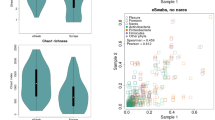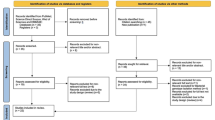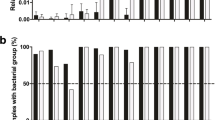Abstract
Microbiome studies have contributed to many fields, such as healthcare and medicine; however, these studies are relatively limited in forensics. Microbiome analyses can provide information, such as geolocation and ancestry information, when short tandem repeat (STR) profiling fails. In this study, methods for DNA extraction and sampling from the skin and saliva were optimized for the construction of a Korean Forensic Microbiome Database (KFMD). DNA yields were estimated using four DNA extraction kits, including two automated kits (Maxwell® FSC DNA IQ™ Casework Kit and PrepFiler™ Forensic DNA Extraction Kit, updated) and two manual kits (QIAamp DNA Mini Kit and QIAamp DNA Micro Kit) commonly used in forensic DNA profiling laboratories. Next-generation sequencing of the 16S rRNA V4 region was performed to analyze microbial communities in samples. The Bacterial Transport Swab with Liquid Media (NobleBio), two cotton swabs (PoongSung and Puritan), and nylon-flocked swabs (NobleBio and COPAN) were tested for DNA recovery. The PrepFiler and Maxwell kits showed the highest yields of 3.884 ng/μL and 23.767 ng/μL from the scalp and saliva, respectively. With respect to DNA recovery, nylon-flocked swabs performed better than cotton swabs. The relative abundances of taxa sorted by DNA extraction kits were similar contributions; however, with significant differences in community composition between scalp and saliva samples. Lawsonella and Veillonella were the most abundant genera in the two sample types. Thus, the Maxwell® FSC DNA IQ™ Casework Kit and nylon-flocked swab (NobleBio) were optimal for DNA extraction and collection in microbiome analyses.









Similar content being viewed by others
Data Availability
The datasets generated during and/or analysed during the current study are available from the corresponding author on reasonable request.
References
Qian XB, Chen T, Xu YP, Chen L, Sun FX, Lu MP, Liu YX (2020) A guide to human microbiome research: study design, sample collection, and bioinformatics analysis. Chin Med J (Engl) 133(15):1844–1855. https://doi.org/10.1097/CM9.0000000000000871
Precone V, Del Monaco V, Esposito MV, De Palma FD, Ruocco A, Salvatore F, D'Argenio V (2015) Cracking the code of human diseases using next-generation sequencing: applications, challenges, and perspectives. BioMed research international 161648. https://doi.org/10.1155/2015/161648
The Integrative HMP (iHMP) Research Network Consortium (2019) The integrative human microbiome project. Nature 569:641–648. https://doi.org/10.1038/s41586-019-1238-8
D'Argenio V (2018) Human microbiome acquisition and bioinformatic challenges in metagenomic studies. Int J Mol Sci 19(2). https://doi.org/10.3390/ijms19020383
Sender R, Fuchs S, Milo R (2016) Revised estimates for the number of human and bacteria cells in the body. PLoS Biol 14(8):e1002533. https://doi.org/10.1371/journal.pbio.1002533
Yao T, Han X, Guan T et al (2021) Exploration of the microbiome community for saliva, skin, and a mixture of both from a population living in Guangdong. Int J Legal Med 135:53–62. https://doi.org/10.1007/s00414-020-02329-6
Lloyd-Price J, Arze C, Ananthakrishnan AN et al (2019) Multi-omics of the gut microbial ecosystem in inflammatory bowel diseases. Nature 569(7758):655–662. https://doi.org/10.1038/s41586-019-1237-9
Sanna S, van Zuydam NR, Mahajan A, Kurilshikov A, Vich Vila A, Võsa U, Mujagic Z, Masclee AAM, Jonkers DMAE, Oosting M, Joosten LAB, Netea MG, Franke L, Zhernakova A, Fu J, Wijmenga C, McCarthy MI (2019) Causal relationships among the gut microbiome, short-chain fatty acids and metabolic diseases. Nat Genet 51(4):600–605. https://doi.org/10.1038/s41588-019-0350-x
De la Cuesta-Zuluaga J, Mueller NT, Álvarez-Quintero R, Velásquez-Mejía EP, Sierra JA, Corrales-Agudelo V, Carmona JA, Abad JM, Escobar JS (2019) Higher fecal short-chain fatty acid levels are associated with gut microbiome dysbiosis, obesity, hypertension and cardiometabolic disease risk factors. Nutrients 11(1):51 (https://www.mdpi.com/2072-6643/11/1/51)
Balachandran M, Cross KL, Podar M (2020) Single-cell genomics and the oral microbiome. J Dent Res 99(6):613–620. https://doi.org/10.1177/0022034520907380
Li Y, Wang K, Zhang B, Tu Q, Yao Y, Cui B, Ren B, He J, Shen X, Van Nostrand JD, Zhou J, Shi W, Xiao L, Lu C, Zhou X (2019) Salivary mycobiome dysbiosis and its potential impact on bacteriome shifts and host immunity in oral lichen planus. Int J Oral Sci 11(2):13. https://doi.org/10.1038/s41368-019-0045-2
Balato A, Cacciapuoti S, Di Caprio R, Marasca C, Masara A, Raimondo A, Fabbrocini G (2019) Human microbiome: composition and role in inflammatory skin diseases. Arch Immunol Ther Exp (Warsz) 67(1):1–18. https://doi.org/10.1007/s00005-018-0528-4
Chen D, He J, Li J, Zou Q, Si J, Guo Y, Yu J, Li C, Wang F, Chan T, Shi H (2021) Microbiome and metabolome analyses reveal novel interplay between the skin microbiota and plasma metabolites in psoriasis. Frontiers in Microbiology 12(535). https://doi.org/10.3389/fmicb.2021.643449
Metcalf JL, Xu ZZ, Bouslimani A, Dorrestein P, Carter DO, Knight R (2017) Microbiome tools for forensic science. Trends Biotechnol 35(9):814–823. https://doi.org/10.1016/j.tibtech.2017.03.006
Eom YB (2018) Microbial forensics: human identification. Biomed Sci Letters. 24:292–304. https://doi.org/10.15616/bsl.2018.24.4.292
Phan K, Barash M, Spindler X et al (2020) Retrieving forensic information about the donor through bacterial profiling. Int J Legal Med 134:21–29. https://doi.org/10.1007/s00414-019-02069-2
Hyde ER, Haarmann DP, Petrosino JF et al (2015) Initial insights into bacterial succession during human decomposition. Int J Legal Med 129:661–671. https://doi.org/10.1007/s00414-014-1128-4
Robinson JM, Pasternak Z, Mason CE, Elhaik E (2021) Forensic applications of microbiomics a review. Frontiers in Microbiology 11(13):608101. https://doi.org/10.3389/fmicb.2020.608101
Lutz H, Vangelatos A, Gottel N, Speed E, Osculati A, Visona S, Finley SJ, Tuomisto S, Karhunen P, Gilbert JA, Javan GT (2019) Manner of death and demographic effects on microbial community composition in organs of the human cadaver. bioRxiv. https://doi.org/10.1101/752576
The MetaSUB International Consortium (2016) The Metagenomics and Metadesign of the Subways and Urban Biomes (MetaSUB) International Consortium inaugural meeting report. Microbiome 4:24. https://doi.org/10.1186/s40168-016-0168-z
Cho HW, Eom YB (2021) Forensic analysis of human microbiome in skin and body fluids based on geographic location. Frontiers in Cellular and Infection Microbiology 11. https://www.frontiersin.org/article/10.3389/fcimb.2021.695191
Diez Lopez C, Kayser M, Vidaki A (2021) Estimating the time since deposition of saliva stains with a targeted bacterial dna approach: a proof-of-principle study. Front Microbiol 12:647933. https://doi.org/10.3389/fmicb.2021.647933
Yj OK, Hee Lee S, Sang You H, Ju Lee Y, Sun Kang S, Hee Hyun S (2021) Estimation of personal environment via fingertip microbiome and mobile phone surfaces. Iran J Biotechnol 19(2):2696. https://doi.org/10.30498/IJB.2021.2696
Coil DA, Neches RY, Lang JM, Jospin G, Brown WE, Cavalier D, Hampton-Marcell J, Gilbert JA, Eisen JA (2020) Bacterial communities associated with cell phones and shoes. PeerJ 8:e9235. https://doi.org/10.7717/peerj.9235
Wilkins D, Tong X, Leung MHY, Mason CE, Lee PKH (2021) Diurnal variation in the human skin microbiome affects accuracy of forensic microbiome matching. Microbiome 9(1):129. https://doi.org/10.1186/s40168-021-01082-1
Young JM, Linacre A (2021) Massively parallel sequencing is unlocking the potential of environmental trace evidence. Forensic Sci Int Genet 50:102393. https://doi.org/10.1016/j.fsigen.2020.102393
Eisenhofer R, Minich JJ, Marotz C, Cooper A, Knight R, Weyrich LS (2018) Contamination in low microbial biomass microbiome studies: issues and recommendations. Trends Microbiol. https://doi.org/10.1016/j.tim.2018.11.003
Weyrich LS, Farrer AG, Eisenhofer R, Arriola LA, Young J, Selway CA, Handsley-Davis M, Adler CJ, Breen J, Cooper A (2019) Laboratory contamination over time during low-biomass sample analysis. Mol Ecol Resour 19(4):982–996. https://doi.org/10.1111/1755-0998.13011
Nearing JT, Comeau AM, Langille MGI (2021) Identifying biases and their potential solutions in human microbiome studies. Microbiome 9(1):113. https://doi.org/10.1186/s40168-021-01059-0
Bjerre RD, Hugerth LW, Boulund F, Seifert M, Johansen JD, Engstrand L (2019) Effects of sampling strategy and DNA extraction on human skin microbiome investigations. Sci Rep 9(1):17287. https://doi.org/10.1038/s41598-019-53599-z
Vesty A, Biswas K, Taylor MW, Gear K, Douglas RG (2017) Evaluating the impact of DNA extraction method on the representation of human oral bacterial and fungal communities. PLoS ONE 12(1):e0169877. https://doi.org/10.1371/journal.pone.0169877
Greathouse KL, Sinha R, Vogtmann E (2019) DNA extraction for human microbiome studies: the issue of standardization. Genome Biol 20(1):212. https://doi.org/10.1186/s13059-019-1843-8
Singh H, Clarke T, Brinkac L, Greco C, Nelson KE (2021) Forensic microbiome database: a tool for forensic geolocation meta-analysis using publicly available 16S rRNA microbiome sequencing. Front Microbiol 12:644861. https://doi.org/10.3389/fmicb.2021.644861
Walters W, Hyde ER, Berg-Lyons D, Ackermann G, Humphrey G, Parada A, Gilbert JA, Jansson JK, Caporaso JG, Fuhrman JA, Apprill A, Knight R (2015) Improved bacterial 16S rRNA gene (V4 and V4–5) and fungal internal transcribed spacer marker gene primers for microbial community surveys. Msystems 1(1):e00009-15. https://doi.org/10.1128/mSystems.00009-15
Bolyen E, Rideout JR et al (2019) Reproducible, interactive, scalable and extensible microbiome data science using QIIME 2. Nat Biotechnol 37:852–857. https://doi.org/10.1038/s41587-019-0209-9
Dhariwal A, Chong J, Habib S, King I, Agellon LB, Xia J (2017) MicrobiomeAnalyst - a web-based tool for comprehensive statistical, visual and meta-analysis of microbiome data. Nucleic Acids Res 45:W180-188. https://doi.org/10.1093/nar/gkx295
Chong J, Liu P, Zhou G, Xia J (2020) Using MicrobiomeAnalyst for comprehensive statistical, functional, and meta-analysis of microbiome data. Nat Protoc 15:799–821. https://doi.org/10.1038/s41596-019-0264-1
Bardenhorst SK, Vital M, Karch A, Rübsamen N (2021) Richness estimation in microbiome data obtained from denoising pipelines. Computational and Structural Biotechnology 20:508–520. https://doi.org/10.1016/j.csbj.2021.12.036
Schmedes SE, Woerner AE, Novroski NMM, Wendt FR, King JL, Stephens KM, Budowle B (2018) Targeted sequencing of clade-specific markers from skin microbiomes for forensic human identification. Forensic Sci Int Genet 32:50–61. https://doi.org/10.1016/j.fsigen.2017.10.004
Callewaert C, Ravard Helffer K, Lebaron P (2020) Skin microbiome and its interplay with the environment. Am J Clin Dermatol 21:4–11. https://doi.org/10.1007/s40257-020-00551-x
The Human Microbiome Project Consortium (2012) Structure, function and diversity of the healthy human microbiome. Nature 486:207–214. https://doi.org/10.1038/nature11234
Krishnan K, Chen T, Paster BJ (2017) A practical guide to the oral microbiome and its relation to health and disease. Oral Dis 23(3):276–286. https://doi.org/10.1111/odi.12509
Cornejo Ulloa P, van der Veen MH, Krom BP (2019) Review: modulation of the oral microbiome by the host to promote ecological balance. Odontology 107:437–448. https://doi.org/10.1007/s10266-019-00413-x
Al-Zyoud W, Hajjo R, Abu-Siniyeh A, Hajjaj S (2019) Salivary microbiome and cigarette smoking: a first of its kind investigation in jordan. Int J Environ Res Public Health 17(1):256. https://doi.org/10.3390/ijerph17010256
Stahringer SS, Clemente JC, Corley RP, Hewitt J, Knights D, Walters WA, Knight R, Krauter KS (2012) Nurture trumps nature in a longitudinal survey of salivary bacterial communities in twins from early adolescence to early adulthood. Genome Research 22(11):2146–2152. https://doi.org/10.1101/gr.140608.112
Gouello A, Dunyach-Remy C, Siatka C, Lavigne JP (2022) Analysis of microbial communities: an emerging tool in forensic sciences. Diagnostics 12:1. https://doi.org/10.3390/diagnostics12010001
Paster BJ, Olsen I, Aas JA (2000) Dewhirst FE (2006) The breadth of bacterial diversity in the human periodontal pocket and other oral sites. Periodontol 42:80–87. https://doi.org/10.1111/j.1600-0757.2006.00174.x
Watanabe K, Nishi E, Tashiro Y, Sakai K (2019) Mode and structure of the bacterial community on human scalp hair. Microbes Environ 34(3):252–259. https://doi.org/10.1264/jsme2.ME19018
He Y, Caporaso JG, Jiang XT et al (2015) Stability of operational taxonomic units: an important but neglected property for analyzing microbial diversity. Microbiome 3:20. https://doi.org/10.1186/s40168-015-0081-x
Morosini MI, Loza E, Guitierrez O, Almaraz F, Baquero F, Canton R (2006) Evaluation of 4 swab transport systems for the recovery of ATCC and clinical strains with characterized resistance mechanisms. Diagn Microbiol Infect Dis 56:19–24. https://doi.org/10.1016/j.diagmicrobio.2006.02.011
Kirkland PD, Frost MJ (2020) The impact of viral transport media on PCR assay results for the detection of nucleic acid from SARS-CoV-2. Pathology 52(7):811–814. https://doi.org/10.1016/j.pathol.2020.09.013
Sushil Kumar Sahu et al (2021) A comparative study of silica spin column based and magnetic bead based RNA extraction and purification kits on COVID-19 samples. Int J Med Res Prof 7(1): 56–62. https://doi.org/10.21276/ijmrp
Ali N, Rampazzo R, Costa A, Krieger MA (2017) Current nucleic acid extraction methods and their implications to point-of-care diagnostics. BioMed research international 9306564. https://doi.org/10.1155/2017/9306564
Pust MM, Tümmler B (2022) Bacterial low-abundant taxa are key determinants of a healthy airway metagenome in the early years of human life. Comput Struct Biotechnol J 20:175–186. https://doi.org/10.1016/j.csbj.2021.12.008
Brownlow RJ, Dagnall KE, Ames CE (2012) A comparison of DNA collection and retrieval from two swab types (cotton and nylon flocked swab) when processed using three QIAGEN extraction methods. J Forensic Sci 57(3):713–717. https://doi.org/10.1111/j.1556-4029.2011.02022.x
Bruijns BB, Tiggelaar RM, Gardeniers H (2018) The extraction and recovery efficiency of pure DNA for different types of swabs. J Forensic Sci 63(5):1492–1499. https://doi.org/10.1111/1556-4029.13837
Viviano M, Willame A, Cohen M, Benski A, Catarino R, Wuillemin C, Vassilakos P (2018) A comparison of cotton and flocked swabs for vaginal self-sample collection. Int J Women’s Health 10:229–236. https://doi.org/10.2147/IJWH.S157897
Wise NM, Wagner SJ, Worst TJ, Sprague JE, Oechsle CM (2021) Comparison of swab types for collection and analysis of microorganisms. MicrobiologyOpen 10(6):e1244. https://doi.org/10.1002/mbo3.1244
Sender R, Fuchs S, Milo R (2016) Revised estimates for the number of human and bacteria cells in the body. PLoS Biol 14(8):e1002533. https://doi.org/10.1371/journal.pbio.1002533
Johnson CL, Versalovic J (2012) The human microbiome and its potential importance to pediatrics. Pediatrics 129(5):950–960. https://doi.org/10.1542/peds.2011-2736
Ahn J, Hayes RB (2021) Environmental influences on the human microbiome and implications for noncommunicable disease. Annu Rev Public Health 42:277–292. https://doi.org/10.1146/annurev-publhealth-012420-105020
Acknowledgements
The authors are grateful for the assistance of Theragen Bio (Seongnam, Republic of Korea).
Funding
This research was supported and funded by the Korean National Police Agency (Project Name: Development of suspect estimation system through convergence intelligent DNA identification/Project Number: PR10-01–000-21). This research was supported by Korea Basic Science Institute (National research Facilities and Equipment Center) grant funded by the Ministry of Education (Grant No. 2020R1A6C101A191).
Author information
Authors and Affiliations
Corresponding author
Ethics declarations
Consent to participate
Informed consent was obtained from all individual participants/donors included in this study.
Conflicts of interest
The authors declare no competing interests.
Additional information
Publisher's note
Springer Nature remains neutral with regard to jurisdictional claims in published maps and institutional affiliations.
Supplementary Information
Below is the link to the electronic supplementary material.
Rights and permissions
Springer Nature or its licensor (e.g. a society or other partner) holds exclusive rights to this article under a publishing agreement with the author(s) or other rightsholder(s); author self-archiving of the accepted manuscript version of this article is solely governed by the terms of such publishing agreement and applicable law.
About this article
Cite this article
Yu, KM., Lee, Am., Cho, HS. et al. Optimization of DNA extraction and sampling methods for successful forensic microbiome analyses of the skin and saliva. Int J Legal Med 137, 63–77 (2023). https://doi.org/10.1007/s00414-022-02919-6
Received:
Accepted:
Published:
Issue Date:
DOI: https://doi.org/10.1007/s00414-022-02919-6




